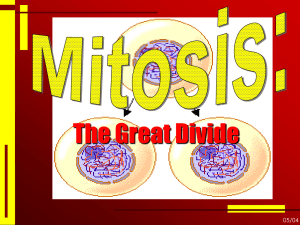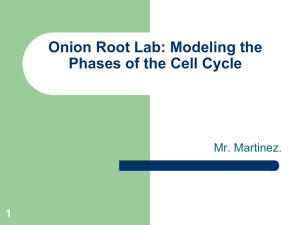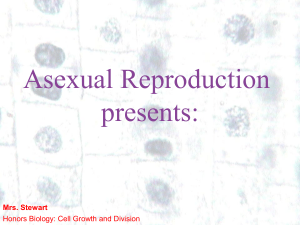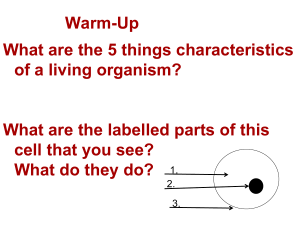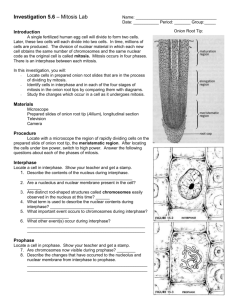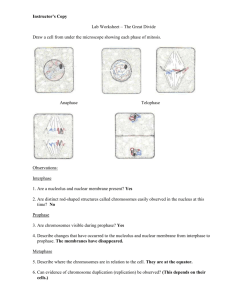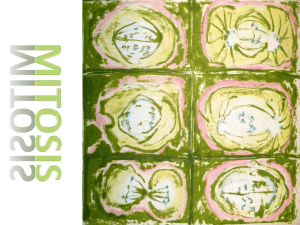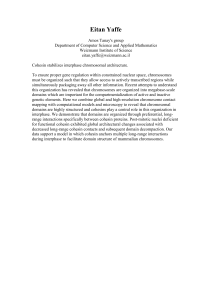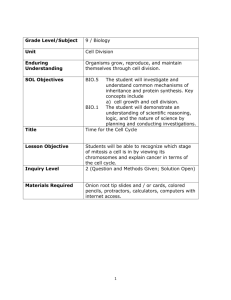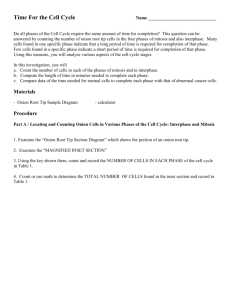CELL CYCLE and THE LENGTH OF EACH
advertisement
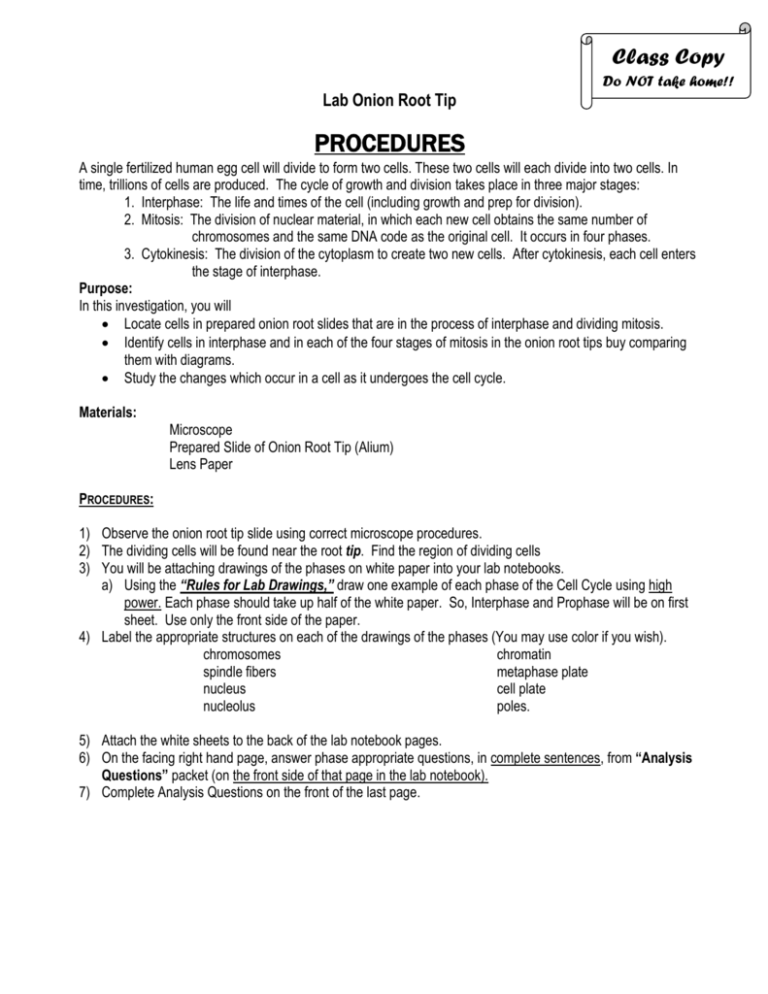
Class Copy Do NOT take home!! Lab Onion Root Tip PROCEDURES A single fertilized human egg cell will divide to form two cells. These two cells will each divide into two cells. In time, trillions of cells are produced. The cycle of growth and division takes place in three major stages: 1. Interphase: The life and times of the cell (including growth and prep for division). 2. Mitosis: The division of nuclear material, in which each new cell obtains the same number of chromosomes and the same DNA code as the original cell. It occurs in four phases. 3. Cytokinesis: The division of the cytoplasm to create two new cells. After cytokinesis, each cell enters the stage of interphase. Purpose: In this investigation, you will Locate cells in prepared onion root slides that are in the process of interphase and dividing mitosis. Identify cells in interphase and in each of the four stages of mitosis in the onion root tips buy comparing them with diagrams. Study the changes which occur in a cell as it undergoes the cell cycle. Materials: Microscope Prepared Slide of Onion Root Tip (Alium) Lens Paper PROCEDURES: 1) Observe the onion root tip slide using correct microscope procedures. 2) The dividing cells will be found near the root tip. Find the region of dividing cells 3) You will be attaching drawings of the phases on white paper into your lab notebooks. a) Using the “Rules for Lab Drawings,” draw one example of each phase of the Cell Cycle using high power. Each phase should take up half of the white paper. So, Interphase and Prophase will be on first sheet. Use only the front side of the paper. 4) Label the appropriate structures on each of the drawings of the phases (You may use color if you wish). chromosomes chromatin spindle fibers metaphase plate nucleus cell plate nucleolus poles. 5) Attach the white sheets to the back of the lab notebook pages. 6) On the facing right hand page, answer phase appropriate questions, in complete sentences, from “Analysis Questions” packet (on the front side of that page in the lab notebook). 7) Complete Analysis Questions on the front of the last page. ANALYSIS QUESTIONS FOR ONION ROOT TIP LAB Answer phase appropriate questions, in complete sentences, from “Mitosis” packet, on bottom half of each page. Answer the questions in complete sentences. Interphase 1. 2. 3. 4. 5. Describe the contents of a nucleus during interphase. Are a nucleolus and a nuclear membrane present in the cell? Are distinct rod-shaped structures called chromosomes easily observed in the nucleus at this time? What term is used to describe nuclear contents during interphase? What important event(s) occurs to chromosomes during interphase? Prophase 6. Are chromosomes now visible during prophase? 7. Describe the changes that have occurred to the nucleolus and nuclear membrane from interphase to prophase. 8. Explain why chromosomes can now be observed but were not observable during interphase. Metaphase 9. Describe where the chromosomes are now located in relation to the cell. 10. Can evidence of chromosome duplication (replication) now be observed? 11. What are the fibers called that become visible during this phase? 13. What term is used to describe the structure at which each fiber attaches to a chromosome? Anaphase 14. In metaphase, chromosome pairs were lined up along the cell’s center. Describe what is occurring to each chromosome pair during anaphase. 15. Toward what area of the cell are the chromosomes being directed? 16. What structure is responsible for the movement of chromosomes during this phase? Telophase/Cytokinesis 17. What cell parts begin to reappear during this phase? 18. How many cells have now formed from an original cell? 19. Explain how the number of chromosomes found in each daughter cell compares to the number found in the original cells before mitosis. (HINT: Read Objectives in Procedure packet). Part 1 Analysis 1. The term “mitosis” comes from the Greek word meaning “thread.” Explain why this word may be helpful in describing this process of nuclear division. 2. Explain how the process of mitosis helps an organism to grow in size.



